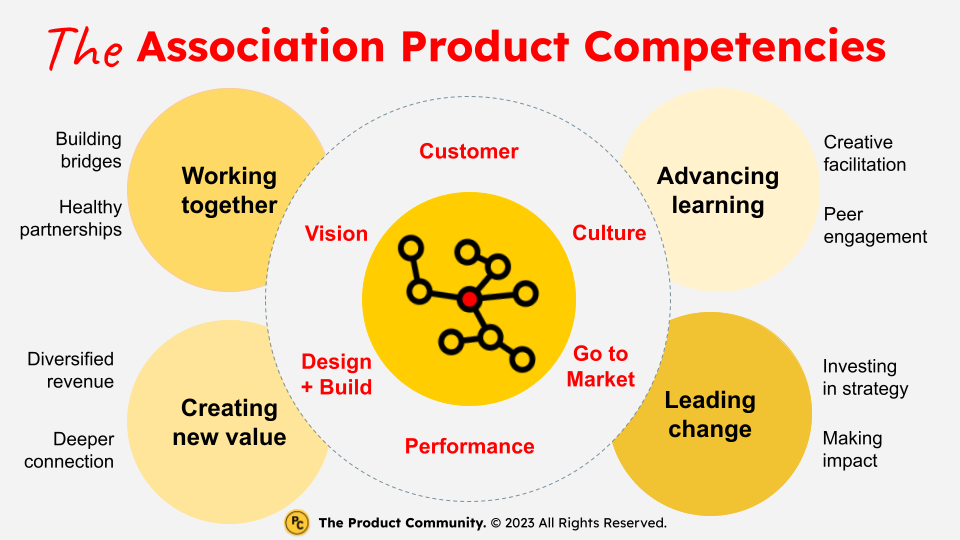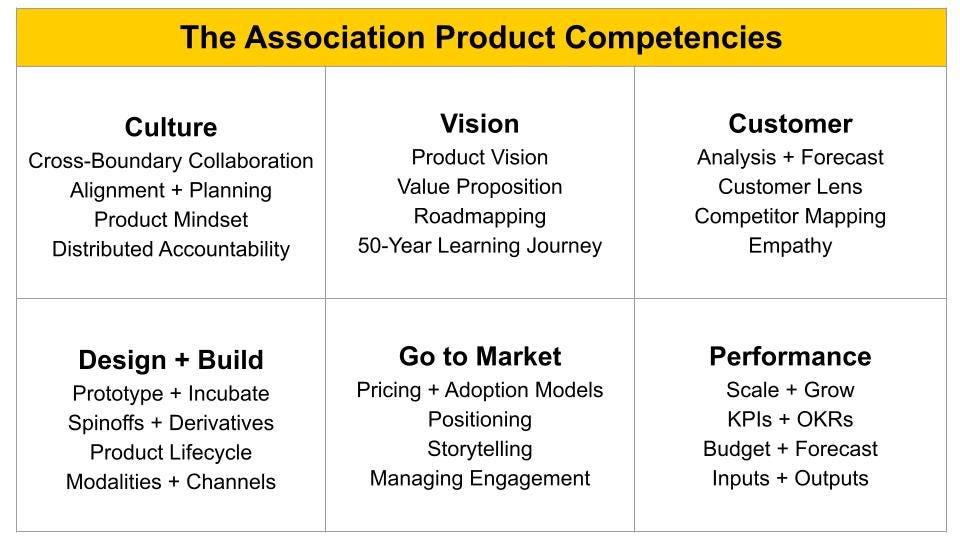Summary
“The future is about creating value. If we have the tools to empower each other, possibility becomes reality.”
Jessica Jackley
Nearly all associations have two things in common: (1) we build community through membership and (2) we’re in the value creation business.
Viewed together through an innovation lens, these two concepts — community and value creation — create the product community.
The product community is a product development learning community designed specifically for associations. A key anchor for the product community are the association product competencies of culture, vision, customer, design + build, go to market, and performance.
This article digs into how the competencies guide membership communities in their value creation efforts. Let’s create something new!
A Shared Commitment to Innovation
“Effective design is invisible.
Scott Belsky
The association product competencies can be used to:
Create new value. As an architecture for innovation to help to guide our value creation activities.
Lead change. To plan and measure progress across our offerings.
Advance learning. To build common language and new capabilities.
Work together. To develop community, trust, and momentum.
As an architecture for innovation, associations can use the competencies, for instance, to create a consistent focused effort in things as wide-ranging as: designing and planning an annual meeting, delivering a newsletter, hosting a podcast, or creating an advocacy program.
We can also use the competencies to bring new ideas to our communities. Over time, they become a shared commitment, an investment in purpose, and an organizational rhythm. How?
By subscribing and reading this free newsletter.
By participating in a workshop.
By joining a cohort.
By signing up for consulting.
The product community utilizes peer engagement to create milestones, drive conversation, and create an experience that meets the needs of participants with diverse areas of expertise and varying levels of experience. This means that learning is more a content dump. It is robust, interactive, engaging, and perpetual.
The association product competencies are a foundation for a shared commitment to growth and a common thread for engagement. Let’s look them in a little more depth.
A Better Way to Create Value for Members
“If we can fall in love with serving people, creating value, solving problems, building valuable connections and doing work that matters, it makes it far more likely we're going to do important work.”
Seth Godin
A key anchor and driver to a successful product community are mastering the six association product competencies of culture, vision, customer, design + build, go to market, and performance. They are vital to creating a culture of innovation and intimately linked to growth: in members, reach, or impact.
One tool we use to guide their use is the product community maturity model. This model is an assessment tool used to gauge progress and measure one’s learning journey (see my article Mapping Progress: How a Maturity Model Can Create a Path for Strategic Growth to learn more).
Like I mentioned, the competencies are flexible and applicable.
Whether you are putting on an event, compiling and distributing a journal, delivering a webinar, or offering a course you can utilize the association product competencies as a repeatable framework to better understand your members, create new value, and measure impact.
Culture — Products drive trust
Vision — Products are anticipatory
Customer — Products solve problems
Design + Build — Products are optimized
Go to Market — Products are in demand
Performance — Products are indispensable
In addition to the built-in adaptability of the association product competencies, they can also be used to anchor your portfolio of offerings so you can leverage your programs, products, and services in new ways to new audiences.
In short, all your offerings can become competency-based and, therefore, increasingly interdependent, anticipatory, and relevant to member needs.
Applying the Association Product Competencies
"Community in the fullest sense is the smallest unit of health."
Wendell Berry
Engaging in the product community is an investment in the future.
I developed it because associations are in trouble: our value proposition has eroded, we longer draw young professionals, and there are new, compelling alternatives to the value we traditionally offer: professional development, networking, content, or gatherings.
What can we do about it? Dig deeper and invest in what we do best: build community and deliver value. Utilizing the association product competencies provides a more strategic, unified way to play this dual role:
They serve as anchors to guide our communities on a shared journey while
helping us build new capability in how to create and deliver new offerings.
In this way, the association product competencies serve a connector purpose:
to connect members to content + experiences in meaningful ways
to connect diverse participants so they can solve problems together
to connect people together in a community of ongoing practice
The association product competencies are a working body of knowledge, refined over time by a network of association professionals who contribute new insights, models, and techniques as they build and get to market new products.
Ultimately, a culture of innovation is formed. The competencies and sample topics are briefly described in this table:
In future posts and product community offerings, we will continue to highlight the association product competencies. Stay tuned!
Remember, product-led growth fuels connection. Join the product community and flip your destiny.
About the Author
James Young is founder and chief learning officer of the product community®. Jim is an engaging trainer and leading thinker in the worlds of associations, learning communities, and product development. Prior to starting the product community®, Jim served as Chief Learning Officer at both the American College of Chest Physicians and the Society of College and University Planning.
Please contact me for a conversation: james@productcommunity.us.







